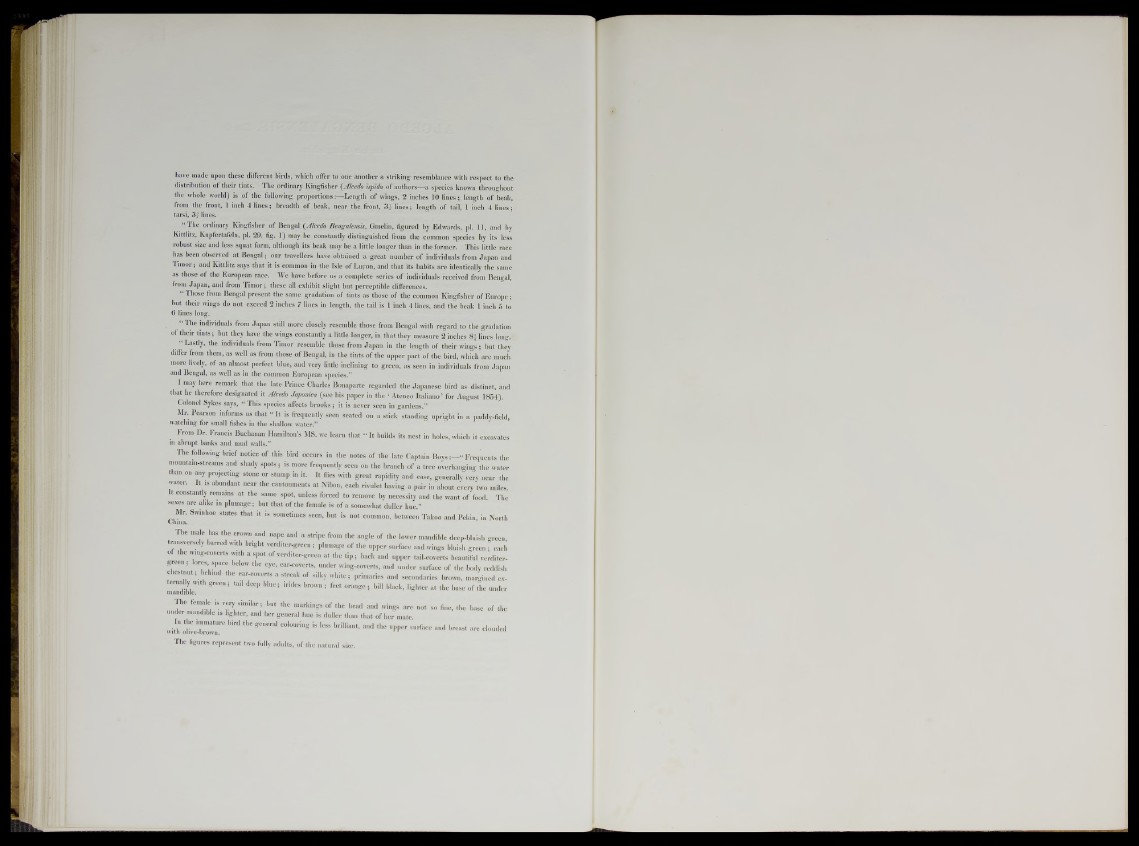
have made upon these different birds, which offer to one another a striking resemblance with respect to the
distribution of their tints. The ordinary Kingfisher (Alcedo ispida of authors—a species known throughout
the whole world) is of the following proportions:—Length of wings, 2 inches 10 lines; length of beak,
from the front, 1 inch 4 lines; breadth of beak, near the front, 3* lines; length of tail, 1 inch 4 lines;
tarsi, 3 f lines.
“ The ordinary Kingfisher of Bengal (Alcedo Bengalensis, Gmelin, figured by Edwards, pi. 11, and by
Kittlitz, Kupfertafeln, pi. 29. fig. 1) may be constantly distinguished from the common species by its less
robust size and less squat form, although its beak may be a little longer than in the former. This little race
has been observed at Bengal; our travellers have obtained a great number of individuals from Japan and
Timor; and Kittlitz says that it is common in the Isle of Lupon, and that its habits are identically the same
as those of the European race. We have before us a complete series of individuals received from Bengal,
from Japan, and from Timor; these all exhibit slight but perceptible differences.
“ Those from Bengal present the same gradation of tints as those of the common Kingfisher of Europe;
but their wings do not exceed 2 inches 7 lines in length, the tail is 1 inch 4 lines, and the beak I inch 5 to
6 lines long.
“ The individuals from Japan still more closely resemble those from Bengal with regard to the gradation
of their tints ; but tbey have the wings constantly a little longer, in that they measure 2 inches 8j- lines long.
“ Lastly, the individuals from Timor resemble those from Japan in the length of their wings; but they
differ from them, as well as from those of Bengal, in the tints of the upper part of the bird, which are much
more lively, of an almost perfect blue, and very little inclining to green, as seen in individuals from Japan
and Bengal, as well as in the common European species.”
I may here remark that the late Prince Charles Bonaparte regarded the Japanese bird as distinct, and
that he therefore designated it Alcedo Japonica (see his paper in the ' Ateneo Italiano’ for August 1854).
Colonel Sykes says, “ This species affects brooks; it is never seen in gardens.”
Mr. Pearson informs us that " It is frequently seen seated on a stick standing upright in a paddy-field,
watching for small fishes in the shallow water.”
From Dr. Francis Buchanan Hamilton's MS. we learn that “ It builds its nest in holes, which it excavates
in abrupt banks and mud walls.”
The following brief notice of this bird occurs in the notes of the late Captain BoysM-“ Frequents the
mountain-streams and shady spots; is more frequently seen on the branch of a tree overhanging the water
than on any projecting stone or stump in it. It flies with great rapidity and ease, generally very near the
water. It is abundant near the cantonments at Nibon, each rivulet having a pair in about every two miles.
It constantly remains at the same spot, unless forced to remove by necessity and the want of food. The
sexes are alike in plumage; but that of the female is of a somewhat duller hue.”
Mr. Swmhoe states that it is sometimes seen, but is not common, between Takoo and Pekin, in North
C/hina.
The male has the crown and nape and a stripe from the angle of the lower mandible deep-bluish *reen
transversely barred with bright verditer-green ; plumage of the upper surface and wings bluish green ? eacl,
of the wing-coverts with a spot of verditer-green at the tip; back and upper tail-coverts beautiful verditer-
green, lores space below the eye, ear-coverts, under wing-coverts, and under surface of the body reddish
chestnut; behind the ear-coverts a streak of silky white; primaries and secondaries brown, margined exnmndible
! 2 deC|> W“C 5 ‘ndeS W ® , 5 feet oranSe 1 W l)lack' lighter at the base of the under
The female is very similar; but the markings of the head and wings are not so fine, the base of the
under mandible is lighter, and her general hue is duller than that of her mate.
In the immature bird the general colouring is less brilliant, and the upper surface and breast a re clouded
wiin onve-Drown.
The figures represent two fully adults, of the natural size.